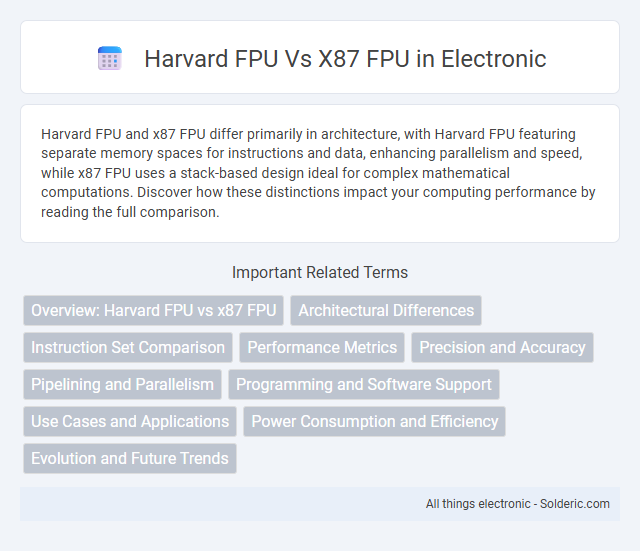Harvard FPU and x87 FPU differ primarily in architecture, with Harvard FPU featuring separate memory spaces for instructions and data, enhancing parallelism and speed, while x87 FPU uses a stack-based design ideal for complex mathematical computations. Discover how these distinctions impact your computing performance by reading the full comparison.
Comparison Table
| Feature | Harvard FPU | x87 FPU |
|---|---|---|
| Architecture Type | Harvard architecture (separate data and instruction memory) | Von Neumann architecture (shared memory for data and instructions) |
| Memory Separation | Separate memory spaces for instructions and data | Unified memory handling instructions and data |
| Register Set | Typically dedicated registers with fixed pipeline | Stack-based floating-point registers (8 registers deep) |
| Instruction Execution | Parallel fetch and execution due to separate caches | Sequential execution with stack manipulation |
| Performance | Higher throughput for floating-point operations due to parallelism | Complex instruction set, slower for some operations |
| Usage | Embedded systems, DSPs, and modern FPUs with pipeline | Legacy x86 processors and software floating-point emulation |
| Complexity | Simpler pipeline design with separate data paths | More complex stack-based handling and microcoded instructions |
Overview: Harvard FPU vs x87 FPU
The Harvard FPU features separate memory spaces for instructions and data, enabling parallel access that enhances computational efficiency in floating-point operations. In contrast, the x87 FPU, integrated within the x86 architecture, uses a unified memory space and an 8-register stack for executing floating-point arithmetic, prioritizing compatibility and precision. Understanding these architectural differences helps you optimize performance in applications requiring intensive floating-point calculations.
Architectural Differences
Harvard FPU architecture separates instruction and data pathways, enabling simultaneous access and execution, which results in increased processing speed and efficiency compared to the x87 FPU's single shared bus for instructions and data. The x87 FPU, integrated with the x86 CPU, uses a stack-based register model, whereas Harvard FPU employs distinct memory buses and separate storage for instructions and data, reducing bottlenecks and improving parallelism. This architectural distinction makes Harvard FPU more suitable for high-performance computing tasks requiring rapid floating-point calculations.
Instruction Set Comparison
Harvard FPU architecture separates instruction and data memory, enabling simultaneous access that enhances pipeline efficiency compared to the x87 FPU's unified memory access. The Harvard FPU typically supports a streamlined, fixed instruction set optimized for floating-point operations, whereas the x87 FPU features a complex, variable-length instruction set with extensive support for transcendental math functions. Your choice between these FPUs impacts instruction throughput and execution efficiency, especially in applications demanding high precision and speed.
Performance Metrics
Harvard FPUs achieve higher throughput and lower latency by utilizing separate instruction and data caches, enabling simultaneous fetch and execution cycles. x87 FPUs, integrated within the CPU's legacy floating-point unit, often exhibit higher latency due to shared bus usage and complex instruction decoding. Your choice depends on requiring faster parallelism and pipelined execution typical of Harvard architectures or legacy compatibility characteristic of x87 designs.
Precision and Accuracy
The Harvard FPU and x87 FPU differ significantly in precision and accuracy, with the Harvard FPU typically offering streamlined operations tailored for specific applications, often resulting in lower precision compared to the highly precise and versatile x87 FPU. The x87 FPU supports extended precision formats, including 80-bit floating-point calculations, which enhance accuracy in complex mathematical computations crucial for scientific and financial tasks. For your needs in high-precision calculations, the x87 FPU generally provides superior numerical accuracy and consistency over the Harvard FPU architecture.
Pipelining and Parallelism
Harvard FPU architecture enables higher pipelining efficiency by separating instruction and data paths, allowing simultaneous fetching and execution stages, which enhances parallelism in floating-point operations. In contrast, the x87 FPU uses a stack-based design with limited pipelining capabilities, leading to lower throughput and reduced parallel execution. Your choice between these FPUs will impact the performance of complex arithmetic computations, especially in applications requiring high-speed parallel processing.
Programming and Software Support
The Harvard FPU architecture improves programming efficiency by separating instruction and data pathways, enabling faster and more parallel processing compared to the x87 FPU's stack-based design. Software support for Harvard FPUs often involves specialized compilers and optimized instruction sets tailored for DSP or embedded systems, whereas the x87 FPU benefits from widespread compatibility with legacy x86 applications and extensive floating-point library support in mainstream operating systems. Compiler optimizations and development tools for the x87 FPU facilitate precise control over floating-point operations, but the Harvard FPU's architecture can yield better throughput in real-time and signal processing software environments.
Use Cases and Applications
The Harvard FPU excels in digital signal processing and real-time embedded systems due to its dedicated instruction and data pathways, enabling faster parallel processing and lower latency. The x87 FPU is commonly used in general-purpose computing environments, providing extensive support for complex floating-point arithmetic in scientific calculations, graphics, and engineering applications. Your choice depends on whether you need high-speed, deterministic performance for specialized hardware or flexible, software-oriented floating-point operations.
Power Consumption and Efficiency
Harvard FPU architecture typically consumes less power than x87 FPU due to separate instruction and data paths, reducing bottlenecks and allowing more efficient parallel processing. The x87 FPU, with its stack-based design and complex instruction set, often results in higher power consumption and lower efficiency during floating-point operations. Harvard FPU's streamlined data flow enhances computational efficiency, making it preferable for energy-sensitive applications.
Evolution and Future Trends
Harvard FPUs, with separate instruction and data pathways, evolved to enhance parallelism and throughput compared to traditional x87 FPUs, which rely on a unified register stack architecture. The x87 FPU, rooted in the 1980s, emphasizes backward compatibility and precision but has been largely superseded by SIMD extensions and dedicated vector units. Future trends favor Harvard-style FPUs integrated within heterogeneous systems-on-chip, leveraging parallelism and energy efficiency for AI and scientific computing workloads.
Harvard FPU vs x87 FPU Infographic

 solderic.com
solderic.com